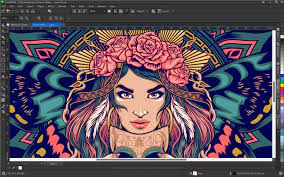Bridging Creativity and Productivity: A Comprehensive Guide to Exporting Files to Office Productivity Applications in CorelDRAW

Introduction:
In the dynamic landscape of graphic design, the synergy between creativity and productivity is paramount. CorelDRAW, a leading vector graphics editor, understands the need for seamless integration with office productivity applications. This comprehensive guide delves into the intricacies of exporting files from CorelDRAW to office applications, exploring formats, tools, and best practices to enhance collaboration, streamline workflows, and empower designers to bring their creative visions to life within the productivity-driven sphere.
I. Understanding the Intersection of Design and Productivity:
- Design Output:
- CorelDRAW serves as a versatile platform for creating visually stunning designs, illustrations, and graphics.
- Exporting designs to office productivity applications enables designers to leverage these creations in business presentations, reports, documents, and more.
- Office Productivity Applications:
- Applications like Microsoft Word, Excel, and PowerPoint are integral to professional environments for document creation, data analysis, and presentation development.
- Exporting CorelDRAW files to these applications ensures a harmonious workflow between design and productivity tasks.
II. CorelDRAW’s Export Capabilities:
- Export Formats:
- CorelDRAW offers a range of export formats suitable for integration with office applications.
- Common formats include PDF, PNG, JPEG, and SVG, each serving specific purposes in various office contexts.
- Compatibility:
- CorelDRAW’s commitment to industry standards ensures compatibility with multiple versions of office productivity applications.
- Designers can export files with confidence, knowing that the integrity of their designs will be maintained when opened in office software.
III. Exporting Vector Graphics to Office Documents:
- PDF as a Universal Format:
- PDF stands out as a universal format for exporting vector graphics from CorelDRAW to office applications.
- PDF files preserve the scalability and clarity of vector designs, making them ideal for documents, presentations, and collaborative projects.
- Configuring PDF Export Settings:
- CorelDRAW provides extensive options for customizing PDF export settings.
- Designers can optimize settings for print, web, or general document use, tailoring the export to the specific requirements of the intended office application.
IV. Exporting Raster Images to Enhance Documents:
- PNG and JPEG for Image Integration:
- When exporting raster images from CorelDRAW, formats like PNG and JPEG are suitable for seamless integration into office documents.
- These formats maintain image quality while allowing for efficient file sizes, ensuring smooth document handling.
- Resolution Considerations:
- Adjusting image resolution during export is crucial for achieving the desired clarity in office applications.
- CorelDRAW’s export settings enable designers to control image resolution, balancing quality with file size.
V. Exporting Infographics and Illustrations:
- SVG for Scalable Vector Graphics:
- Scalable Vector Graphics (SVG) is an ideal format for exporting intricate infographics and illustrations.
- SVG files maintain the scalability and detail of designs, ensuring high-quality visuals when embedded in office documents.
- Compatibility with Office Applications:
- SVG files are well-supported by many office productivity applications, providing a versatile option for exporting complex vector graphics.
VI. Customizing Exported Content for Office Use:
- Image Editing in CorelDRAW:
- CorelDRAW’s image editing capabilities empower designers to refine and optimize exported content.
- Adjustments, enhancements, and final touches can be applied within CorelDRAW before exporting to ensure the exported content aligns seamlessly with the intended office application.
- Text Elements and Font Embedding:
- Pay attention to text elements when exporting to office applications.
- CorelDRAW allows for font embedding, ensuring that text appears as intended, even if the office application doesn’t have access to the original fonts.
VII. Collaborative Considerations:
- Documenting Export Settings:
- When collaborating with colleagues using office applications, document your export settings.
- Clear documentation ensures that exported files align with the intended use and formatting standards within the collaborative environment.
- Transparent Communication:
- Transparent communication with collaborators is crucial for successful integration.
- Clearly communicate any specific design considerations, resolutions, or formatting requirements to ensure a smooth transition from CorelDRAW to the office application.
VIII. Troubleshooting and Tips:
- Version Compatibility:
- Be mindful of version compatibility between CorelDRAW and office applications.
- Regularly updating software ensures that exported files seamlessly integrate with the latest features and functionalities of office productivity applications.
- Export Presets:
- Consider creating export presets in CorelDRAW for specific office applications.
- Presets streamline the export process, ensuring consistent output and minimizing the need for manual adjustments with each export.
IX. Continuous Learning and Adaptation:
- Explore New Features:
- Stay informed about updates to both CorelDRAW and office applications.
- Exploring new features and functionalities enhances the export process and allows designers to leverage the latest tools for seamless integration.
- Community and Resources:
- Engage with the design community and explore online resources.
- Learning from others’ experiences, sharing insights, and seeking advice contribute to continuous improvement in the export process.
Conclusion:
In conclusion, CorelDRAW’s robust export capabilities empower designers to seamlessly integrate their creative endeavors into office productivity applications. By understanding the compatibility of export formats, optimizing settings, and customizing content for office use, designers can bridge the gap between creativity and productivity with finesse. As the design and productivity landscapes continue to evolve, CorelDRAW remains a reliable companion, offering designers the tools and knowledge needed to navigate the intersection of creative expression and professional documentation.




